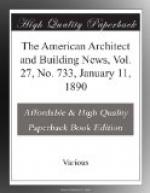The casts once received, they must be put together, sometimes repaired and finally set up. Pedestals must be built for the statues, wall-spaces prepared for the reliefs. Therefore, a small force of skilled plaster-workers and carpenters is necessary. In Norwich most of the plaster-work was done by two men, a third being added occasionally, and the aggregate of this item in the expenses was $1,626.75. With regard to the carpentry, more work of this kind than would usually be necessary was required by the fact that a number of changes had to be made in order to adapt the hall to its use as a museum of art, its destination not having been determined when the building itself was completed. Consequently, some of the $4,690 paid for material and labor in this department would form a part of the building expenses in a structure designed especially for the purpose.
These were the principal expenses in the preparation of the Slater Museum. On photographs about $800 have been spent thus far, the electrotype coins cost something less than $750, and the balance of the total quoted was made up by such incidentals as the draperies and upholstering, photograph frames, the designer’s commission and petty expenses.
Turning now for a moment to the other side of the balance-sheet, we shall try to answer the question, “Does it pay” to undertake a work of this kind, except in our large and central cities? If to the founder or founders of such an institution it be sufficient recompense for their liberality to see their gift used, appreciated and enjoyed by people of all classes, the brief experience of the Slater Memorial Museum answers the question with a strong affirmative. The Museum was dedicated on November 22 of last year. Since then it has been open regularly ten hours a week, divided among three days, and at other times to students and visitors from a distance. It is always free. There being no automatic machine for registering the admissions, Mr. Kent has requested visitors to write their names in a book provided for the purpose. The number who do so is naturally considerably less than the total number of visitors, particularly when the Museum is crowded, yet up to date the books show more than 10,000 names. The average attendance per week thus recorded, from the time of opening to July 1, was 283, the best month being December, in which 2,163 names were entered, the poorest June, with a total of 483. Especially gratifying has been the attendance on holidays, which shows that the interest in the Museum is by no means confined to those who have plenty of leisure. On Thanksgiving Day 800 names were registered, Christmas 932, New Year’s 732, Decoration Day 850. For the benefit of the mill-operatives and other laborers who form the largest portion of the population of Norwich and the adjoining towns, to whom the Museum might do a world of good, we sincerely hope the day is not far distant when the building may be open at least a couple of hours each Sunday. The experience of the Boston Museum of Fine Arts in Sunday opening has been an unqualified success, and we wish that Norwich, as well as our own city, might profit by it. In Boston, we are told, the average number of admissions during the Sunday hours has reached as high as 1,000 per hour, and of these probably four-fifths are common workmen with their families.




